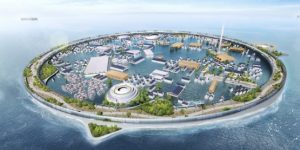Hugely ambitious self-sufficient floating city to host 40,000 people
Japan’s N-Ark has revealed plans for an incredibly ambitious floating city that would host tourism, medical facilities, and even space rockets. Named Dogen City, it would be designed to take any climate change-related sea rises in its stride and provide power, food and water for up to 40,000 people.
Dogen City would measure 4 km (almost 2.5 miles) in circumference. It would have a capacity for approximately 10,000 full-time inhabitants, plus there could also be up to 30,000 tourists visiting at any time. Its circular form would be designed to withstand severe weather and even tsunamis, though no further details are available at this early stage.
We do know that the project would be arranged into three distinct areas: the so-called habitable ring containing the main housing zone, an undersea data center which would be naturally cooled by the sea and contain city management and medical research facilities, and floating architecture within the artificial bay created by the ring-shaped structure.

There would also be lots of greenery, food production facilities, a school, sports areas, hospitals, parks, stadiums, hotels, and offices. Additionally, as mentioned, N-Ark envisions Dogen City including some kind of launch and landing site for rocket transportation. Healthcare is also a major focus and residents would have access to telemedicine consultations and high-tech blood analysis for possible issues, as well as robotic surgery and drug research.
N-Ark has done its math and reckons that there would be around 2 million liters (roughly 530,000 gallons) of water consumption per year, which sounds rather modest, plus 3,288 tons of annual garbage disposal. Almost 7,000 tons of food would be produced and 22,265,000 kW of power would be generated. Meeting all these needs would definitely be a huge undertaking and details on how the floating city would do so are light at this stage, though the renders provided do show lots of solar panels and the food growing facilities mentioned.
We’ve no word yet on where the project would be located, nor its budget, though N-Ark envisions it being in use by 2030. As for how likely it is to go ahead, we wouldn’t like to bet on it. However in a world where the Line is currently under construction, we wouldn’t rule it out either.


